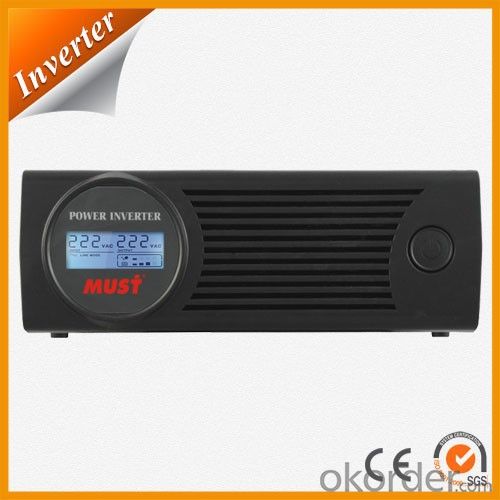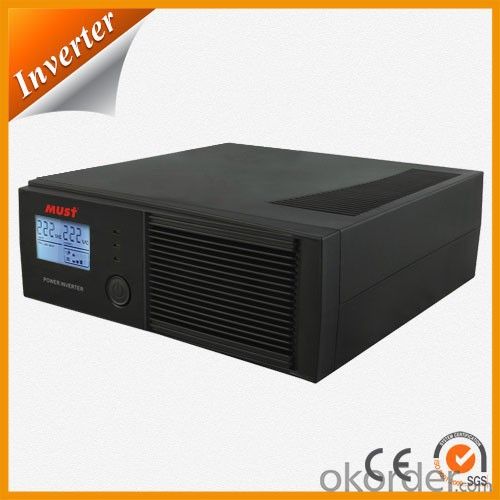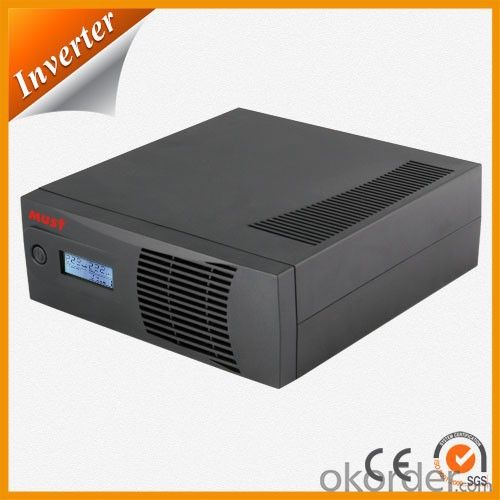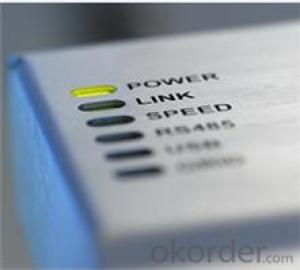Mini Solar Inverter CE Approved EP1000 with Competitive Price
- Loading Port:
- China main port
- Payment Terms:
- TT or LC
- Min Order Qty:
- 50 unit
- Supply Capability:
- 1000 unit/month
OKorder Service Pledge
OKorder Financial Service
You Might Also Like
Features:
Main for home and office Appliance such as TV,refrigerator,fan,lights,computer etc.
1.User selectable for accepting wider input voltage.
2.Rack Tower design, high Frequency, off mode charging.
3.Compact size for convenient use and storage.
4.Built-in from 8Amp super charger up to 100Ah battery.
5.Small scale and cost effective inverter for home appliances and office equipments
6.Three – steps Three – steps intelligent charging control to recharging time.
NEW Function:10A/20A charging current adjustable .
Four new panel for your reference
Front panel & Sockets
Inside Structure
Rated Capacity | 500VA/300W | 1000VA/600W | 2000VA/1200W |
Input | |||
Models | 120V Models | 230V Models | |
Nominal Voltage | 110V/115V/120V Selectable | 220V/230V/240V Selectable | |
Input Frequency | 47Hz ~ 65Hz, 50/60Hz Auto-Sensing | ||
Efficiency | 95%(Normal Mode) | ||
Noise Filtering | Full Time EMI/RFI Filtering | ||
Over Current Protection | By Re-Settable Over Current Protector | ||
Voltage Range | 90 - 145VAC Or 170-280VAC ( Narrow Range ) | ||
Surge Protection | 324 Joules | ||
Output | |||
Rated Power | 500va/300w | 1000VA/600W | 2000VA/12000W |
Output Voltage | 100V/110V/115V/120V Selectable | 220V/230V/240v selectable | |
Voltage Waveform | Modified Sine Wave | ||
Crest Factor | 3:01 | ||
Output Frequency (Synchronized-Mains) | Auto Select For 50/60Hz 47Hz ~ 55Hz For 50Hz Nominal; 56Hz ~ 65Hz For 60Hz Nominal | ||
Regulation(Battery Mode) | 10% -18% | ||
Transfer Time | 15ms Typical 50ms Max | ||
Protection | Over Load, Discharge, Overcharged | ||
Battery Type | Lead-Acid 12V 25Ah ~ 250Ah | ||
Voltage | 500VA/1000VA :DC12V ; 2000VA :DC24V | ||
Backup Time | Depend On Battery | ||
Charging Method | 3 Steps Super Charge Mode | ||
Charging Current | 10A-20A Adjustable Charge Current | ||
Protection | Over Current Protection Over Charging Voltage Protection (No More Than 15V) Deep Discharge, Overload Protection | ||
Communications & Management | |||
Control Panel(LCD Indicator) | Input & Output Voltage, Battery Capacity, | ||
Audible Alarm | Low Battery | Sounding Every 2 Seconds | |
Overload | Sounding Every 0.5 Second | ||
Fault | Continuously Sounding | ||
Environment And Safety | |||
Operating Environment | 0~40 Degrees Centigrade, 0 - 90% Non Condensing | ||
Transit/Storage | -15℃ To 55℃ (5℉ To 131℉) D39 | ||
Operating Altitude | 0 ~ 3000 Meters | ||
Audible Noise | ≦50dba | ||
Safety Markings | CE.FCC | ||
Quality Control System | ISO 9001 | ||
Physical | |||
Dimensions (H×D×W) | 355*130*230mm | ||
N.W/G.W(Kg) | 1.6/2 (Kg) | 2/2.3 (Kg) | 2.2/2.6 (Kg) |
Packing | 6pcs/Carton | ||
Warranty
provides a 1~3 year limited warranty (“Warranty”) against defects in materials and workmanship for its Uninterruptible power supply, Power inverter/chargers, Solar charge controllers, Battery Products (“Product”).
The term of this Warranty begins on the Product(s) initial purchase date, or the date of receipt of the Product(s) by the end user, whichever is later. This must be indicated on the invoice, bill of sale, and/or warranty registration card submitted to MUST-Solar. This Warranty applies to the original MUST-Solar Product purchaser, and is transferable only if the Product remains installed in the original use location.
FAQ
1. How do I decide which system is right for me ?
For protection from long outages, include a generator or solar panels in your Must solar system. Shorter outages can be handled by a battery-only system.
2. Where my system will be installed ?
Must solar systems are usually wall-mounted near a home's main electrical (circuit breaker) panel.
3. How do I install my system ?
A must solar backup inverter is connected to a home electric system , we will supply detailed installation manual and videos for our customers .
Images
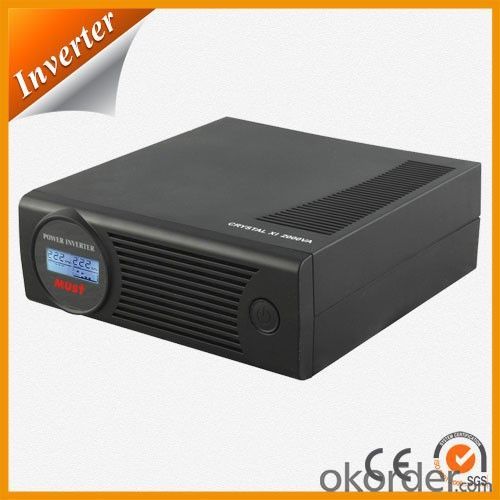
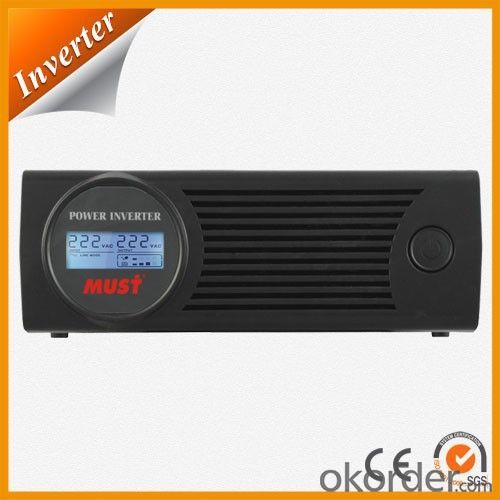
- Q: How do you calculate the efficiency loss due to temperature for a solar inverter?
- To calculate the efficiency loss due to temperature for a solar inverter, you would typically refer to the manufacturer's specifications and documentation. The efficiency loss can be determined by comparing the inverter's rated efficiency at a specific temperature (usually 25 degrees Celsius) to its efficiency at the desired operating temperature. The manufacturer may provide a temperature coefficient, which represents the percentage decrease in efficiency for every degree increase in temperature. By multiplying the temperature coefficient with the difference between the desired operating temperature and the reference temperature, you can estimate the efficiency loss due to temperature.
- Q: How does a solar inverter handle overloading?
- A solar inverter handles overloading by constantly monitoring the power output from the solar panels and the load demand. If the load demand exceeds the maximum capacity of the inverter, it will automatically reduce the power output or shut down to prevent any damage or overheating. This ensures the safety and optimal performance of the inverter and the connected devices.
- Q: What is the role of a power backup system in a solar inverter?
- The role of a power backup system in a solar inverter is to provide a reliable source of electricity during periods of insufficient sunlight or power grid outages. It ensures uninterrupted power supply to critical loads, such as essential appliances or equipment, by utilizing stored energy from batteries or alternative power sources. This backup system enhances the overall reliability and functionality of the solar inverter, making it more suitable for both grid-tied and off-grid applications.
- Q: What is the role of a solar inverter in a utility-scale system?
- The role of a solar inverter in a utility-scale system is to convert the direct current (DC) electricity produced by the solar panels into alternating current (AC) electricity that can be used by the electrical grid. It ensures the compatibility between the solar power generated and the grid's requirements, including voltage, frequency, and power quality. Additionally, solar inverters often have monitoring and control functions, allowing for remote monitoring and optimization of the system's performance.
- Q: Can a solar inverter be integrated with energy management systems?
- Yes, a solar inverter can be integrated with energy management systems. Solar inverters can be connected to energy management systems to monitor and control the generation and consumption of solar energy. This integration allows for better optimization of energy usage, real-time monitoring of solar production, and intelligent management of energy flows within a building or grid.
- Q: Can a solar inverter be used in areas with high dust and dirt accumulation?
- Yes, a solar inverter can be used in areas with high dust and dirt accumulation. However, it is important to regularly clean and maintain the inverter to prevent any performance issues caused by the accumulation of dust and dirt.
- Q: How does a solar inverter handle variations in grid voltage?
- A solar inverter handles variations in grid voltage by constantly monitoring the voltage level of the grid. When there are fluctuations or variations in the grid voltage, the inverter adjusts its own output voltage accordingly to ensure a stable and consistent supply of electricity from the solar panels. This allows the inverter to efficiently convert the DC power generated by the solar panels into AC power that matches the grid voltage.
- Q: What are the potential risks of over-discharging a battery connected to a solar inverter?
- The potential risks of over-discharging a battery connected to a solar inverter include reduced battery lifespan, decreased battery performance, and potential damage to the battery cells. Over-discharging can lead to deep cycling, causing the battery to degrade faster and lose its capacity to hold a charge effectively. This can result in shorter backup power duration during periods of low solar generation. Additionally, excessive discharge can cause irreversible damage to the battery cells, leading to reduced overall battery performance and potential safety hazards.
- Q: What is a solar inverter?
- A solar inverter is a device that converts the direct current (DC) electricity generated by solar panels into alternating current (AC) electricity that can be used to power household appliances and be fed back into the grid.
- Q: Can a solar inverter be used with a solar-powered electric vehicle charging station?
- Yes, a solar inverter can be used with a solar-powered electric vehicle charging station. The solar inverter helps convert the direct current (DC) power produced by the solar panels into alternating current (AC) power that can be used to charge electric vehicles. This allows for efficient and sustainable charging of electric vehicles using solar energy.
Send your message to us
Mini Solar Inverter CE Approved EP1000 with Competitive Price
- Loading Port:
- China main port
- Payment Terms:
- TT or LC
- Min Order Qty:
- 50 unit
- Supply Capability:
- 1000 unit/month
OKorder Service Pledge
OKorder Financial Service
Similar products
Hot products
Hot Searches
Related keywords





